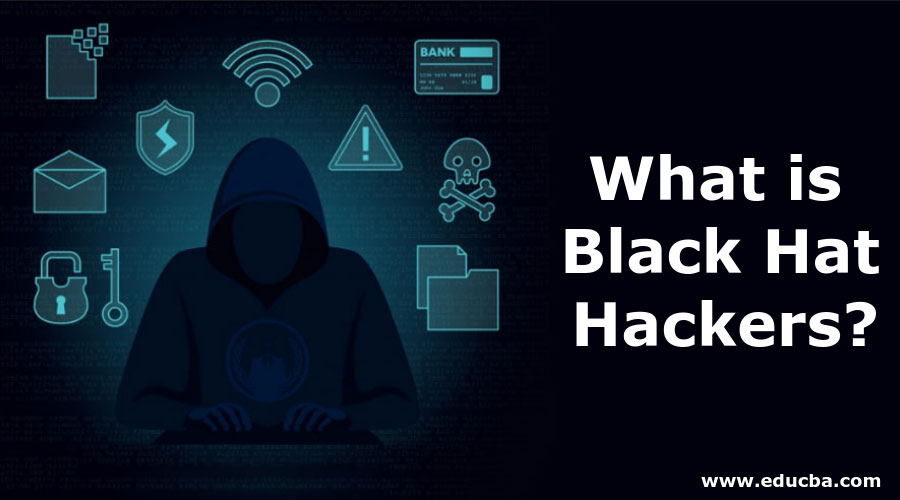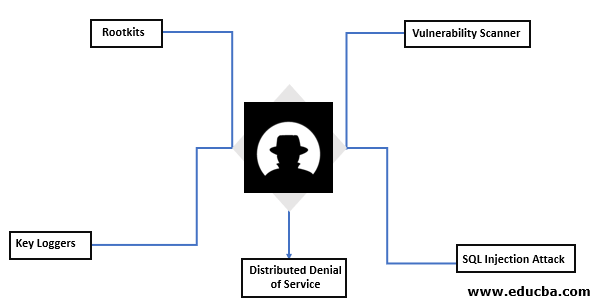Updated March 21, 2023
Introduction to Black Hat Hackers
Black Hat hackers are criminals who have maliciously hacked into computer networks. This can also unleash malware that destroys files, refuses computers, steals passwords, credit card numbers, and other personal data. However, hacking has become a major tool for government intelligence gathering. Black Hat operates more often for easy money alone or with organized criminal organizations. One example is the WannaCry ransomware released in May 2017. It infected around 400,000 computers in 150 countries during the first two weeks of the release.
Is Black Hat Hacking Illegal?
Hacking is not illegal because all hacking is not for criminal activity. Anyhow black hat hacking is illegal, and the results of black hat hacking are considered as cyber crimes that make black hat hacking a criminal activity. Black hat hacking is illegal because it breaks policies and TOS, it hurts fair play and a free market, etc. The most common cybercrime is accessing a system or network without permission and stealing the data from the system, which is also black hat hacking. The cybercrimes range from class B misdemeanors carrying a penalty of six months in prison and a thousand dollars fine to class B felonies carrying a penalty of twenty years in prison and a fifteen thousand dollars fine in the united states.
The hacker Albert Gonzalez had stolen one hundred and seventy million credit cards and any time money numbers, and he was sentenced to twenty years in prison. This is one of the serious cybercrimes in the history of the United States. Albert Gonzalez and his co-workers were made to pay back hundreds of millions of dollars. All such types of black hat hackers are being arrested and charged not only in the united states but all over the world.
What do Black Hat Hackers do?
The black hat hackers make use of a variety of techniques to accomplish a perfect hack without permission. Some of the techniques are:
1. Rootkits
A set of programs that allow hackers to control the computer system and get connected to the internet is called a rootkit. Basically, the rootkit was a backdoor to the computer to fix certain software issues, but hackers are using rootkits to steal control of the operating system from legitimate users. The rootkits can be installed in several different ways in the victim’s system; one is social engineering and phishing attacks. The hacker can illegally gain access and control the system by stealing the information or turning off the system by installing the rootkits in the system.
2. Key Loggers
Every key pressed on the keyboard can be recorded or logged using this specially designed tool called key logger. Every keystroke on the computer keyboard is recorded by clinging to the application programming interface by the key logger. Then the recorded file is saved, and the recorded file contains important data like usernames, the websites visited, etc. Suppose the personal details are being typed on the keyboard of the computer like credit card details, passwords, etc. The keylogger can capture them. Cybercriminals steal sensitive data by using keyloggers which arrive into the system as malware.
3. Vulnerability Scanner
The weaknesses in the network, system, etc., can be identified using a vulnerability scanner. Ethical hackers use vulnerability scanners to find loopholes in the system and fix them. But black hat scanners misuse the vulnerability scanner to find out the system’s weak spots and exploit the system.
4. SQL Injection Attack
To exploit the data in the database, structured query language (SQL) is used. The type of cyber attack in which the databases are tricked through structured query language statements is SQL Injection Attack. A website interface is used to execute this kind of cyber-attack, and this is used to hack usernames, passwords, and database information. The applications that have poor coding are prone to SQL Injection Attacks because these websites contain user input fields that can be easily hacked by code manipulation.
5. Distributed Denial of Service (DDOS)
The normal traffic to enter the server is distorted, resulting in a denial of service by a malicious attack known as distributed denial of service attack. It is a traffic jam that blocks the road and prevents the regular traffic from reaching their destination. The devices that can be easily connected to the network like computers, IoT devices, mobile phones, etc., are prone to distributed denial of service attacks.
Conclusion
It is too difficult to stop the black hat hacking problem because black hat hacking is global. Law enforcement faces many challenges regarding black hat hacking because the hackers leave no proofs and use unsuspecting victim’s computers. In order to protect ourselves from these hackers, we must be proactive, keep the firewall turned on, update good antivirus software and install all operating system updates.
Recommended Articles
This has been a guide to What is Black Hat Hackers? Here we discuss the introduction, what does it do, and the techniques of black hat hackers. You may also have a look at the following articles to learn more –



